Rain and fog envelope the small farmhouse in the village of Tenants Harbor, Maine, where James “Jamie” Browning Wyeth sits in the parlor talking about what it’s like to be the third generation of America’s first family of art. Although he turns 65 this summer, Jamie is a still-boyish man, handsome with a full head of hair, relaxed, candid, and, like his father, Andrew Wyeth (1917-2009), a dapper dresser given to mandarin collars, turtlenecks, tunics, aprons, and knickers—the habit of a country squire.
Despite all the ways that he is like his father, and they are many, Jamie is a very different kind of artist and very much his own man. “I grew up with the legacy thing. My father did, too,” he says. “That could crush you unless you left it outside the door of the studio. In a funny sense, though, my grandfather, who I never knew, had more of an influence on me.”
Newell Convers “N.C.” Wyeth (1882-1945) died in a tragic train-car accident in Chadds Ford, Pennsylvania, the year before Jamie was born. N.C. Wyeth was a larger-than-life figure, a swashbuckler of a man whose dramatic illustrations fired the imaginations of generations of readers beginning with his first illustration commission—a bucking bronco painted for the cover of the February 21, 1903, issue of The Saturday Evening Post.
By comparison, Jamie’s father, Andrew, was a quiet, reserved, and far more subtle and secretive man. Growing up in Chadds Ford, young Jamie played in his late grandfather’s studio amidst the costumes and props used in his grandfather’s pictures of cowboys and Indians, pirates and warriors. “For a kid, it was just magical. Then I’d go to my father’s studio where he’d be working on a dead bird or dried grass.”
Andrew became one of America’s most popular painters—the austere poet laureate of rural life in coastal Maine and Pennsylvania’s Brandywine Valley. Like his father and grandfather before him, Jamie paints both these places as well, the personal poles of the Wyeth world. And in each place the family has a museum devoted to its art—the Farnsworth Art Museum’s Wyeth Center in Rockland, Maine, and the Brandywine River Museum in Chadds Ford, Pennsylvania.
Where his father was a somber tone poet who sucked all the air and color out of local scenes in Maine and Pennsylvania leaving only the painted bones for eternity, Jamie paints with a lively, bold, colorful playfulness and freedom that recalls the melodrama of his grandfather’s illustrations for children’s classics such as Treasure Island, The Deerslayer, and Kidnapped.
Jamie generally marks his own decision to become an artist at 1958, the year he completed the sixth grade and, at his own request, left formal education behind to study art—first with his aunt, Carolyn Wyeth, and then with his father. Andrew, too, had been homeschooled and mentored by his father.
Young Jamie had already entered American art history, however, as one of his father’s subjects. “Faraway” (1952) depicts six-year-old Jamie sitting in a field in a coonskin cap with a distant look in his eyes (top, right). Jamie, a big Davy Crockett fan at the time, still remembers the hat, the boots he wore, and the long hours spent posing for his father. “I had a lead soldier that I played with every time my father took a break,” he recalls. “I lost it in the grass. I looked everywhere for it, but I couldn’t find it. I had dreams about that soldier.”
N.C. Wyeth was a hugely successful illustrator, but his attempts to paint landscapes were nowhere near as successful as his son Andrew’s. “His non-illustration work was rather self-conscious,” says Jamie of his grandfather. “There was this tremendous pride in his son but also this terrible jealousy.” The professional relationship between Jamie and his own father had elements of friendly rivalry, too, but it was far healthier. “In terms of painting, we were completely honest with one another,” says Jamie. “That I really miss.”
Although Andrew was enormously popular, his very popularity was the kiss of death in the contemporary art world, which—having embraced abstract expressionism in the 1950s—tended to view him as a throwback, a nostalgic realist. “Andrew Wyeth was one of the most misunderstood painters,” says his son. “He was no more a realist than the man in the moon. He painted a very strange, airless world.”
Jamie compares his father’s New England Gothic imagery to the spare poetry of Robert Frost. “At one level, it’s all snowy woods and stone walls,” he says. “At another, it’s terrifying. It exists at both levels.”
Still, Andrew’s paintings tend to exist in that gray area between critical scorn and public adulation. “I was at the Museum of Modern Art recently and there was a crowd around ‘Christina’s World,’” says Jamie of his father’s most famous painting, the iconic image of disabled spinster Christina Olson crawling back across a field to her Maine farmhouse. “The museum hates it. They hang it in a hall. But the guards will tell you the two most asked questions at the museum are ‘Where’s the men’s room?’ and ‘Where is “Christina’s World?”’”
The other charge that the art establishment throws at the Wyeths—all three of them—is that they are illustrators rather than artists. “I’ve always taken it as a supreme compliment,” Jamie said in a 1998 interview. “What’s wrong with illustration? There’s this thing now that illustrations are sort of secondary to art, and I think it’s a bunch of crap.”
Reminded of that defiant statement today, Jamie notes that the beloved painter Norman Rockwell was denigrated in the same manner. “I’ve always found Rockwell amazing,” he says, “but my father loathed him. He was almost threatened by Rockwell. He said he had no imagination—that he did everything from photographs with syrupy emotions.”
Jamie himself has no qualms whatsoever about answering the call to illustrate. One of his most recent projects was to paint pictures for the children’s book Sammy in the Sky, a realistic tale of canine love and loss by Pulitzer Prize-winning journalist Barbara Walsh. And, despite his occasional forays across the border into commercial art, his pure-art credentials remain untarnished. That’s partly because, unlike his father, he makes the effort to know and be known in the rarified art world. “He is far more interested than his father was in seeing what’s out there, and living in New York as he does part of the year is itself a statement about his engagement with the world of contemporary art,” says Michael Komanecky, chief curator at the Farnsworth Art Museum. He also notes that as a young man Jamie spent a lot of time at Andy Warhol’s Factory, arguably the epicenter of 20th century American art.
“With Warhol,” says Jamie, “I was just curious about him as a person. This peculiar little man in a wig just fascinated the heck out of me.”
Victoria Wyeth, daughter of Jamie’s brother Nicholas and Andrew Wyeth’s only grandchild, is the designated family docent, giving lectures on all things Wyeth when not working as a therapist in the Pennsylvania state hospital system. She sees her uncle’s art as much more varied than her grandfather’s. “Jamie is the future of our family,” says Victoria. “And he’s so different. He’s managed to do his own thing in his own style, and he’s painted everything from pigs to presidents.”
“Jamie’s art is more openly expressive and expansive, soliciting a wide range of emotions,” adds Wanda Corn, professor emerita of art history at Stanford University, author of The Art of Andrew Wyeth, and a board member of the Wyeth Foundation for American Art. “He can be funny, horrific, ghoulish, and theatrical. His brush is often wild and his color riotous. He enjoys provoking his viewers, making them feel extreme emotion. He is a great animal painter.”
A good-humored menagerie of dogs, geese, gulls, sheep, ravens, chickens, cows, horses, ducks, and especially pigs populate Jamie’s paintings. Enormous, pink, intelligent, clean, and forthright, pigs have become almost a totem animal for Jamie. As he explains in the text to the catalogue to his current exhibition, “Farm Work,” he first took a shine to pigs when a neighbor’s pig, a sow with a crooked snout named Den-Den, got into his studio and ate some of his oil paints. “Months later they were sending her to the butcher,” Jamie recalls. “I thought, I can’t have that. By consuming and surviving twenty-two tubes of my paint, she had endeared herself to me. So I took her to our farm at Point Lookout.” A steady stream of pig paintings ensued.
“The whole family has a wonderful sense of humor,” says Victoria, “and Jamie’s the one who paints with it.”
At almost any given time there is a Wyeth family exhibition somewhere in the world. “The Wyeth Family: Three Generations of American Art; Works from the Bank of America Collection” spent the summer of 2010 at the Dulwich Picture Gallery in London and will be featured at the Mona Bismarck Foundation in Paris from November 26, 2011, to March 6, 2012. Jamie’s “Farm Work” exhibition, which features his animal paintings, runs through September 11, 2011, at the Brandywine River Museum. And in 2014, Jamie’s own lifetime of art will be featured in a major retrospective at the Museum of Fine Art in Boston.
“I hate having shows,” Jamie confides. “All the inadequacies in the paintings scream out to me. Painting is so difficult, it reduces the three generations thing to nothing.”
But Jamie will soldier on, bearing the Wyeth family banner high into the 21st century, both because he wants to and because his father expected him to do so. It is his pleasure, his birthright, and his duty.
Andrew’s final words to his son were simple and direct—”Just give them hell.”
N.C. Wyeth
Learn more about Jamie and his work in our 2016 feature, “Jamie Wyeth: Born to Paint.”
N.C. Wyeth
May 20, 1905
N.C. Wyeth
November 30, 1907
N.C. Wyeth
February 22, 1908
N.C. Wyeth
July 18, 1908
N.C. Wyeth
September 26, 1908
N.C. Wyeth
Country Gentleman March 2, 1918
N.C. Wyeth
Country Gentleman November 1, 1926
N.C. Wyeth
June 1, 1944
N.C. Wyeth
November 1, 1944
N.C. Wyeth
December 1 , 1925
Andrew Wyeth
Andrew Wyeth
October 16, 1943
Andrew Wyeth
October 1, 1950
Jamie Wyeth
Jamie Wyeth
Jamie Wyeth
Jamie Wyeth
Jamie Wyeth
Jamie Wyeth
Jamie Wyeth
Jamie Wyeth
Jamie Wyeth
Become a Saturday Evening Post member and enjoy unlimited access. Subscribe now


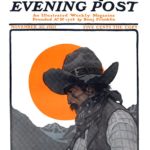
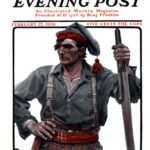
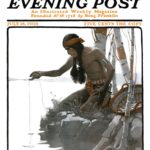





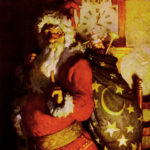
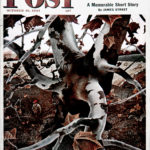





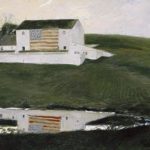

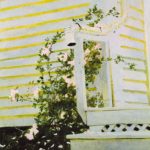



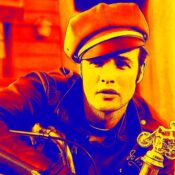
Comments
We had the opportunity to visit the Brandywine Museum last year. Had always adored Andrew’s work, but was amazed by N.C. and Jamie, as well. Your article inspires me to visit Boston in 2014 (at 84). Wish me luck.
Jamie Wyeth’s art is warm and comforting – an everyday look with a beautiful brush.
Andrew Wyeth has been my favorite painter for years now. The starkness of his paintings remind me of my childhood days. Jamie mentions Robert Frost, a favorite poet of mine, to his dad with his spare poetry.
I was fortunate to see Jamie Wyeth’s collection here at a gallery in Chicago years ago. You walked upstairs and there was the dog, big, black and beautiful. Jamie’s father has been my favorite painter – sorry Jamie.